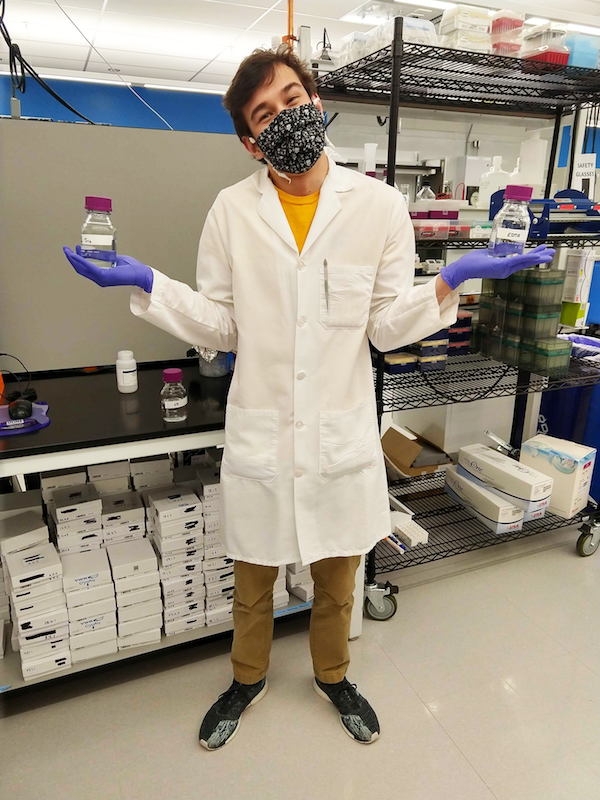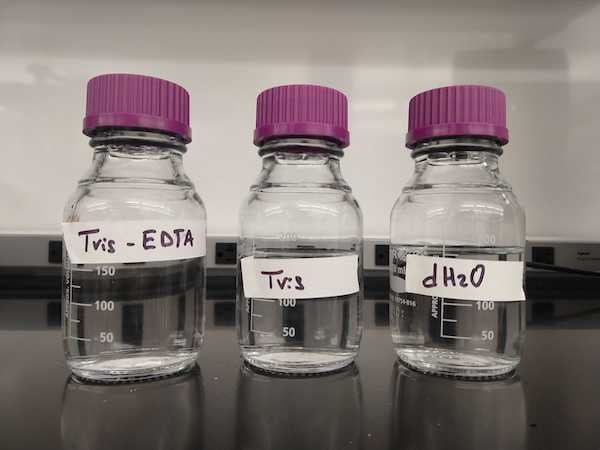If you use a kit for DNA purification or if you use a DIY purification protocol, you might have noticed that there are many options to elute your DNA prep. You might see protocols that recommend eluting in water, Tris-EDTA (TE), just Tris buffer, or some other variations. Does it make a difference? Short answer: yes. This last step will influence the stability of your sample over time and determine which experiments you can effectively use the DNA.
pH and DNases affect DNA stability
 |
| Figure 1: So many choices! What to do? |
The main factors that can affect DNA stability in solution are pH and DNase contamination.
Extreme pH can denature, break, and even change the DNA sequence. High pH favors the breakage of the hydrogen bonds, destabilizing the molecule and favoring the separation of the two helixes. Low pH instead results in the breakage of the ester bonds responsible for the sugar backbone of the DNA helix or even changes the DNA sequence through a mechanism called depurination. In depurination, the hydrolysis of the glycosidic bond leads to the release of a purine (adenine or guanine) from the DNA. These apurinic sites if in double stranded DNA are repaired by base excision repair, but can lead to mutations in single stranded DNA undergoing replication.
DNase on the other hand can digest and degrade the double helix, fragmenting plasmid DNA, PCR product, or chromosome. One of the main causes of degradation during plasmid DNA extraction and purification from E. coli is the presence of the protein endonuclease I encoded by the gene endA. Nowadays, the most common E. coli strains used for plasmid amplification are endA negative, meaning the gene has been removed/mutated to neutralize the nuclease activity. For strains that still carry this gene, there are usually extra steps like heat inactivation, protein degradation, and/or the use of chelating agents that can be introduced in the purification protocol to remove endonucleases activity.
For these reasons choosing the correct solution is fundamental, and it will impact the time you will be able to store your sample without having substantial degradation and which experiments you can use your plasmid.
DNA elution choices: TE, Tris buffer, or water
 |
| Figure 2: Tris-EDTA, Tris, or water? The buffer you choose could affect your downstream experiment. |
TE (10 mM Tris-HCl,1 mM EDTA, pH 8.0) buffer is the best buffer for preserving the stability of your preparation for a long time. Tris buffer controls the pH, while the EDTA chelates any divalent cations like Mg2+, preventing the activity of DNase. While this is very important to preserve the stability of your DNA, it will limit what you can do with these samples. This is because divalent cations are essential cofactors for many tools used in modern molecular biology like restriction enzymes and polymerases. In the situation where you need to use plasmid in TE for any enzymatic reaction, an effective possibility is to dilute your sample in water to reduce the EDTA concentration.
Alternatively, if the priority is to directly use your DNA preparation in any downstream application involving enzymatic reactions, a valid alternative can be Tris buffer (with no EDTA) or water. These are two of the choices that companies offer for the elution of plasmid DNA through their kit. The advantage of using a Tris buffer is that it allows better control of the pH preparation stabilizing the plasmid, and still allowing most downstream processing. On the other hand, nuclease free water is a great option because it provides a great versatility on how to use your plasmid in every type of experiment. The two solutions may differ though in their capacity to maintain DNA stability during storage over prolonged periods of time, especially at room temperature or at 4°C.
Storing DNA: temperature and longevity
You should consider a couple of more things when you elute your DNA: where you plan to store it and for how long. The most common solution is to keep your plasmid at -20°C or even at -80°C, in this case your preparation can be eluted in water or in your buffer of preference, and it will be stable for years. Plasmid DNA can be stable at 4°C or even room temperature for a short period, and there are indications that Tris buffer is better than water in these conditions.
The next time you do a plasmid prep, plan in detail before you drop that elution buffer onto your DNA. Knowing how you want to use the plasmid DNA can help you choose the best way to store and elute the DNA.
References
Murakami M (2013) Evaluation of DNA Plasmid Storage Conditions. The Open Biotechnology Journal 7:10–14 . https://doi.org/10.2174/1874070701307010010
Additional resources on the Addgene blog
- Find five ways to purify DNA without a kit
- Read our blog posts about plasmid cloning
- Browse our Plasmids 101 blog posts
Resources on Addgene.org
- Check out the Molecular Biology Reference
- Find protocols on plasmid cloning
- Find plasmids for your research






Leave a Comment